
You’ve got the destination picked, the vacation dates scheduled, the time-off request approved, and now it’s time to pack. But what type of carry-on luggage will be the best choice to transport your gear? As airlines continue to narrow their carry-on requirements, it pays to be savvy with luggage, especially when toting unwieldy adventure gear. Here’s how to make the most of your carry-on opportunities.
Types of Carry-On Luggage
Any bag you bring on the airplane with you is considered carry-on luggage. It stays with you, as opposed to checked luggage, which is loaded into the cargo hold of the plane. Many airlines allow you to bring a “personal item,” but these are usually limited to small bags that aren’t meant to hold clothing and gear for extended stays. Depending on what airline you’re flying, carry-on luggage is sometimes referred to as cabin luggage or hand luggage.
Generally, airlines allow carry-ons measuring 20 to 22 inches tall, 13 to 16 inches wide, and 7 to 10 inches deep. Some carriers impose weight restrictions (usually around 15 to 25 pounds maximum), but most won’t weigh carry-on luggage.
Carry-on luggage sizes aren’t standardized, and the exact dimensions of what’s allowed on the plane varies between airlines. Always check your airline’s carry-on rules before your flight. To make sure your bag is allowed, measure its height, width, and depth and compare them to the carry-on rules of your airline. Keep in mind that some carriers count the height of wheels and handles, but most don’t.
As you shop, you’ll come across three main types of carry-on luggage.
Backpack
If you’ll be moving frequently once you arrive at your destination, a backpack is often the best choice because it’s easy to carry around from point A to point B and beyond. Most 65-liter backpacks, when packed efficiently (i.e. without items dangling outside and not overstuffed), fit within airline carry-on luggage dimensions.
Duffel
With their large packing cavities, duffels are a great pick for packing awkwardly shaped items and larger volumes of clothing and gear.
Suitcase
A more traditional option, a wheeled carry-on suitcase makes negotiating airports and urban-scapes a breeze thanks to its wheels plus extendable and adjustable handles. If you’ll be tackling a lot of stairs (or dealing with other on-the-move transportation from boats to buses), however, a lighter weight option that allows for hands-free mobility, like a backpack or an easy-carrying duffel, is a better option.
Choosing What You Need
Knowing how you’ll be using your carry-on luggage—a quick turnaround, a long weekend, or an extended escape—will help you narrow down your shopping. Use these parameters to determine the luggage type and features you’ll need for a successful trip.
Storage Capacity
First, identify what you need to bring on your trip. Lay out all the items and then use a paper grocery bag (standard measurement: 15 by 12 by 7 inches) to estimate the volume of space your carry-on should have. Don’t buy a bigger carry-on than you need—that extra space will just become an invitation to pack unnecessary items.
Handling Comfort
Traditional wheeled luggage is designed to be pulled along the ground and isn’t always easy to carry; backpacks and duffels are better suited for off-the-ground handling and long-distance travel away from groomed surfaces.
Backpacks, of course, necesitate carrying the weight of your luggage on your back, and duffels require one of your shoulders or hands to bear the weight. Identify what type of infrastructure will be available at your destination (will you have to walk far?) to determine what type of luggage will be easiest to use. Then examine the strap systems on backpacks and duffels (more on that below), as well as the handles on wheeled suitcases to assess how comfortable they are to carry.
Price
High-end carry-on luggage can easily cost you several hundred dollars, but more affordable options are readily available. When browsing, identify the features you need so you can equip yourself well without unnecessarily breaking the bank. Weatherproofed hard-shell and soft-shell materials, for example (only necessary for certain adventures), come at higher costs. Extra-durable materials (like ripstop polyester or 600-denier nylon) can go the distance again and again, but also run up price points. Also, lightweight outer materials like aluminum, plus extra technology features (like USB charging ports and LED lights), can make your travel experience easier, but for a higher cost. All things considered, if you’re looking for a basic system to carry your belongings, you can find something budget-friendly.























